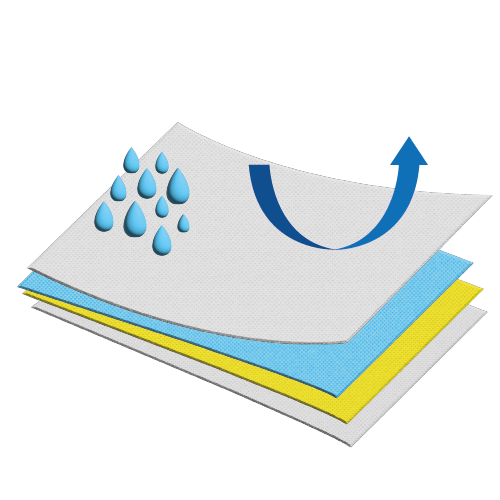Garments selection
Steps for the selection of
Protective Garments
Step 1: Hazard identification
What chemical hazard is it? Gas, liquid, vapor or particles?
Could a change of state of the dangerous substance occur during its use?
(eg from liquid to vapor)?
What are the levels of concentration, humidity, temperature and pressure?
Are there any additional hazards, such as risk of explosion, heat and flames, biohazard, etc.?
Step 2: Determine the minimum levels of protection required
When choosing protective garments, consider the type of exposure and identify the corresponding Type classification.
Analyze the results obtained from the tests for the Type of suit, the material and the seams indicated in the product documentation issued by the manufacturer.
Step 3: Toxicity Hazard Evaluation
It is essential to know the toxicity or consequences of exposure to hazard in both the short and long term.
Evaluate whether a suit that meets the requirements of a certain type constitutes sufficient protection.
Step 4: Determine material and seam protection performance requirements
It should be noted that chemical liquid penetration tests are performed in a period of time of only 60 seconds.
To assess whether the material protects the user for longer periods of time, the permeability data (collected from tests carried out over 8 hours) should be consulted.
Step 5: Determine mechanical performance requirements
An excellent protective barrier is only valid if it survives the working conditions
and remains intact for the duration of the task.
In addition, it is essential to choose the correct size to ensure correct protection. Suits that are too baggy or too tight should be avoided and ensure that the correct size is available. See instructions for use.
Step 6: Comfort Considerations
Protection is important, and so is comfort.
Identifying the right mechanical performance and protection features, while enhancing user comfort, can contribute to user satisfaction and productivity
.
Step 7: Identify the correct use of the product
The limitations of the product must be taken into account, since they can be a source of information for its correct use.
They can also raise important questions such as whether additional sealing is required, whether to consider grounding requirements, performance when exposed to temperatures, or whether a specific suit removal procedure needs to be shown to avoid contamination.
Step 8: Wear and Tear Test
Once the selection is made
why not try on the coverall and evaluate its performance with the position?
Putting a product through wear and tear testing is a wise step in the selection process.
Protective Garments
The operators of any industry are exposed every day to different hazards that can threaten their safety or health while carrying out their work.
As a barrier to these hazards, the operator must be provided with the appropriate Protective Garments, which will depend on and be valued according to the type of work that is carried out.
It is important that the worker wears the garment specifically designed for the risks corresponding to his or her job, because a garment designed for a specific function may not be appropriate and may not protect in another similar situation. Furthermore, said protective garment, according to Royal Decree 773/1997, must be certified in accordance with the provisions of Regulation (EU) 2016/425.
All protective garments complies with the provisions of the UNE-EN ISO 13688 norm. Protective Garments General requirements, in addition to what is indicated in its specific standard.
Hazards
Chemical
Chemical protective garments
The function of garments for chemical and biological protection is to protect workers who work in environments where liquid or solid chemical products, asbestos, paints, oils, grease, viruses and pathogens carried in blood are handled or come into contact with any of the countless pollutants that exist today.
Tight and non-tight gas protection
Type 1 & Type 2
UNE-EN 943-1:2015
Protective Garments against chemicals, liquids and gases, including liquid aerosols and solid particles. Part 1: Performance requirements for chemical protective suits, ventilated and non-ventilated, gas-tight (Type 1) and non-gas-tight (Type 2).
UNE-EN 943-2:2019
Protective Garments against chemicals, liquids and gases, including liquid aerosols and solid particles. Part 2: Performance requirements for gas-tight (Type 1) chemical protective suits intended for emergency equipment (ET).
Gas-tight suits. They cover the entire body, including hands, feet and head.
They are sub classified into 3 types:
- Type 1a B-ET: Gas-tight suit with supply of breathing air independent of the atmosphere. Equipos de respiración autónoma (ERA) interior.
- Type 1b: Gas-tight suit with supply of breathing air independent of the atmosphere. Outdoor self-contained breathing apparatus (SCBA).
- Type 1c: Gas-tight suit with a supply of breathing air from an external source generating positive pressure inside the suit. Air line.
Protection against pressurized liquid chemicals
Type 3B
Type PB [3] B
UNE-EN 14605:2005+A1:2009
Protective garments against liquid chemicals. Performance requirements for garments with liquid-tight seams (Type 3), including garments that offers protection only to certain parts of the body (Type PB [3]).
Against liquid aerosols
Type 4B
Type PB [4] B
UNE-EN 14605:2005+A1:2009
Protective garments against liquid chemicals. Performance requirements for garments with spray-tight seams (Type 4), including garments that offers protection only to certain parts of the body (Type PB [4]).
Against solid chemical particles in suspension
Type 5B
UNE-EN ISO 13982-1:2005/A1:2011
Protective garments for use against solid particles.
Part 1: Performance requirements for chemical protective garments that offers full body protection against airborne solid particles. (Garments type 5). (ISO 13982-1:2004/AM 1:2010).
Against splashes
Type 6B
Type PB [6] B
UNE-EN 13034:2005+A1:2009
Protective garments against liquid chemicals. Performance requirements for chemical protective garments that offers limited protection against liquid chemicals (Type 6).
Type 3, 4, 5, and 6 chemical protective garments may consist of one or two pieces of garment (used simultaneously), with or without a hood, gloves, and/or boots. When the hood, gloves and/or boots are not an integral part of the garment, the compatibility between the PPE must be verified.
Many chemicals can cause serious and permanent injury to a worker who has not been protected or has been inadequately protected. Thus, emphasis must be placed on carefully selecting protective work uniforms once the potential for exposure to such chemicals has been determined.
Biological
Biological hazard is defined as possible exposure to microorganisms that can lead to diseases, motivated by work activity.
Its transmission can be through respiratory, digestive, blood, skin or mucous membranes.
The prevention of biological hazard at work must avoid occupational exposures capable of causing some type of infection, allergy or toxicity.
In addition, each person has an individual susceptibility, which explains why some get sick when they come into contact with a certain biological agent, while others do not (depending on their previous immunization, vaccinations or other personal characteristics).
Biological agents with infectious capacity can be diverse (viruses, bacteria, parasites, fungi or spores, toxins, endotoxins, cell cultures, etc.) or this contact to occur, there must be a transmission route that allows the agent to come into contact with the organ or system where the agent in question can cause damage.
Is there a risk of collective spread?

Garments for each category of infectious agent
UNE-EN 14126:2004
Protective Garments Requirements and test methods for protective garments against biological agents.
Blood resistance ISO/FDIS 16603
(ISO 16604 precursor test)
Resistance to blood pathogens
ISO 16604
resistance to penetration of infectious agents by contact
EN ISO 22610
Resistance to contaminated aerosols
ISO/DIS 22611
Resistance to contaminated particles
ISO 22612
Nuclear
Tests based on Suspended Particle Barrier with Radioactive load.
- EN 1073-1 Ventilated Suits
- EN 1073-2 Non-Ventilated suit
Antistatic
Flame and heat
Protective garments against Heat and Flames
In industrial applications, the main thermal hazards against which workers must be protected are heat and flame, heat from electric arc and molten metal splash.
The condition and amount of heat, flame or fire to which the worker may be exposed is expressed – among others – in terms of:
- Energía incidente Estimated incident energy, measured in cal/cm2 or kW.s/m2, medida en cal/cm2 o kW.s/m2
- Heat flux, or rate of heat flowing through a unit area measured in cal/cm2/sec or kW/m2
Guide to European standards
To simplify the selection of chemical protective workwear, the European Union has developed six “types” of garments. Certification of a particular type indicates the protection the suit will offer against a particular hazard (gas, liquid or dust).
Just because a garment meets these standards doesn’t mean it will fully protect you from danger In these tests only the garments are required to meet the established minimum performance requirements.
Heat and Flames

EN 531
prEN ISO 11612
Electric arc

IEC 61482-1 / IEC 61482-1-1/CDV
IEC 61482-1-2 / IEC 61482-2/CDV
Small splashes of molten metal
EN 470-1
EN ISO 11612
ATEX zones
An explosive atmosphere is understood as the mixture with air, under atmospheric conditions, of flammable substances in the form of gases, vapors, mists or dust, in which, after ignition, combustion spreads to the entire unburned mixture.
According to article 7 of R.D. 681/2003, the employer must classify into zones, in accordance with annex I of that regulation, the areas in which explosive atmospheres can be formed. This classification into zones will be applied to the areas in which protection measures must be taken to prevent explosions.
Risk areas are classified into zones taking into account the frequency with which explosive atmospheres occur and their duration.

First of all, it is important to note that although the R.D. 144/2016 on equipment and protection systems for use in potentially explosive atmospheres, excludes PPE from the scope of application, they must provide an adequate level of safety in the work carried out in these environments.
Being the R.D. 681/2003 which specifically indicates, in annex II of protection measures against explosions, that footwear and work clothes must be used that do not give rise to electrostatic discharges that can cause the ignition of atmospheres.
According to the above, the use of clothing and footwear suitable for the dissipation of electrostatic charges that could accumulate in the worker is decisive, according to the harmonized standards EN 1149-5 and EN 20345, respectively, thus avoiding any potential focus of ignition.
In addition, these environments are areas at risk of fire, so it is necessary to protect the worker with fireproof clothing, according to the harmonized standard EN 11612, which meets the requirement of limiting the spread of flame and protecting against certain types of transmission of heat.
Explosivity Groups
- Acetone / Benzene / Toluene
- Ethylene / Ethylene Oxide / Diethyl Ether
- Acetylene / Hydrogen / Carbon Disulfide
Protective equipment for ATEX zones
- Tyvek® 400 / Tyvek® 500
- ProteHo® FlaRe
- ProteHo® HD CLASSIC
- ProteHo® LP ANTISTATIC
- ProteHo® AdVance
- PartiGuard® Light / PartiGuard®
- Propguard®
- Proshield® 20 SFR
- JetGuard®
- Tychem® 2000 C
- Tyvek® 800 J
- Tychem® 4000 S
- Tychem® 6000 F
- Tychem® 4000 S
- Tychem® 6000 F
- Tychem® 6000 FR ThermoPro
- JetGuard® Plus
High visibility
Electric arcs
Welding
Seams
It is necessary to consider the leaks towards the outside of particles or fibers that penetrate the garment through the seam or the fabric itself due to its lack of filtering towards the outside.
It is necessary to take into account not only the characteristics of the fabric, but also the JOINTS.





SEWN
Resistant particle and liquid barrier
· Sewn seams offer a good balance between the strength of the seams and their barrier effect.
HEAT SEALED
Resistant particle and liquid barrier
· Joining two ends of raw material/fabric of the garment by ultrasound; a watertight seam is achieved with the same physical and chemical characteristics as the raw material/fabric.
COATED
Resistant particle and liquid barrier
The tapes used in this type of sewing offer the same level of barrier as that of the raw material/fabric of the garment.
ULTRASONICALLY WELDED
Resistant particle and liquid barrier
TOP COVER
Very resistant and good barrier particles and liquids
Fabrics

SMS FLAME RETARDANT
- CAT II
- Layers
- SPUNBONDED
- MELTBLOWN
- SPUNBONDED

SMS
- CAT III, T 5 y 6
- Layers
- SPUNBONDED
- MELTBLOWN
- SPUNBONDED

MICROPOROUS
- CAT III, T 4B + 5 y 6
- Layers
- NON WOVEN SUPPORT
- MICROPOROUS POLIMER

Tyvek®
- CAT III, T 4B + 5 y 6
- Layers: Tyvek®

Tyvek® 800
- CAT III, T 3B + 4, 5 y 6
- Layers
- Tyvek®
- POLIMERIC PROTECTION FILM

Tychem® C / Duoform®
- CAT III, T 3B + 4, 5 y 6
- Layers
- TYVEK® o DUOFORM®
- POLIMERIC PROTECTION FILM

Tychem® 4000
- CAT III, T 3B + 4, 5 y 6
- Layers
- TYVEK®
- POLIMERIC PROTECTION FILM x 3

Tychem® F / Tessaform®
- CAT III, T 3B + 4, 5 y 6
- Layers
- TYCHEM® F o TESSAFORM
- POLIMERIC PROTECTION FILM x 3

Tychem® 6000 FR
- CAT III, T 3B + 4, 5 y 6
- Layers
- TYCHEM®
- NOMEX®

Tychem® TK
- CAT III, T 1a B-ET, 2B,3,4,5 y 6
- Layers
- POLIMERIC PROTECTION FILM x 2
- NONWOVEN SUPPORT POLYESTER
- POLIMERIC PROTECTION FILM x 2

EptaForm®
- CAT III, T 1a B-ET, 2B,3,4,5 y 6
- Layers
- POLIMERIC PROTECTION FILM x 2
- NONWOVEN SUPPORT POLYESTER
- POLIMERIC PROTECTION FILM x 2











